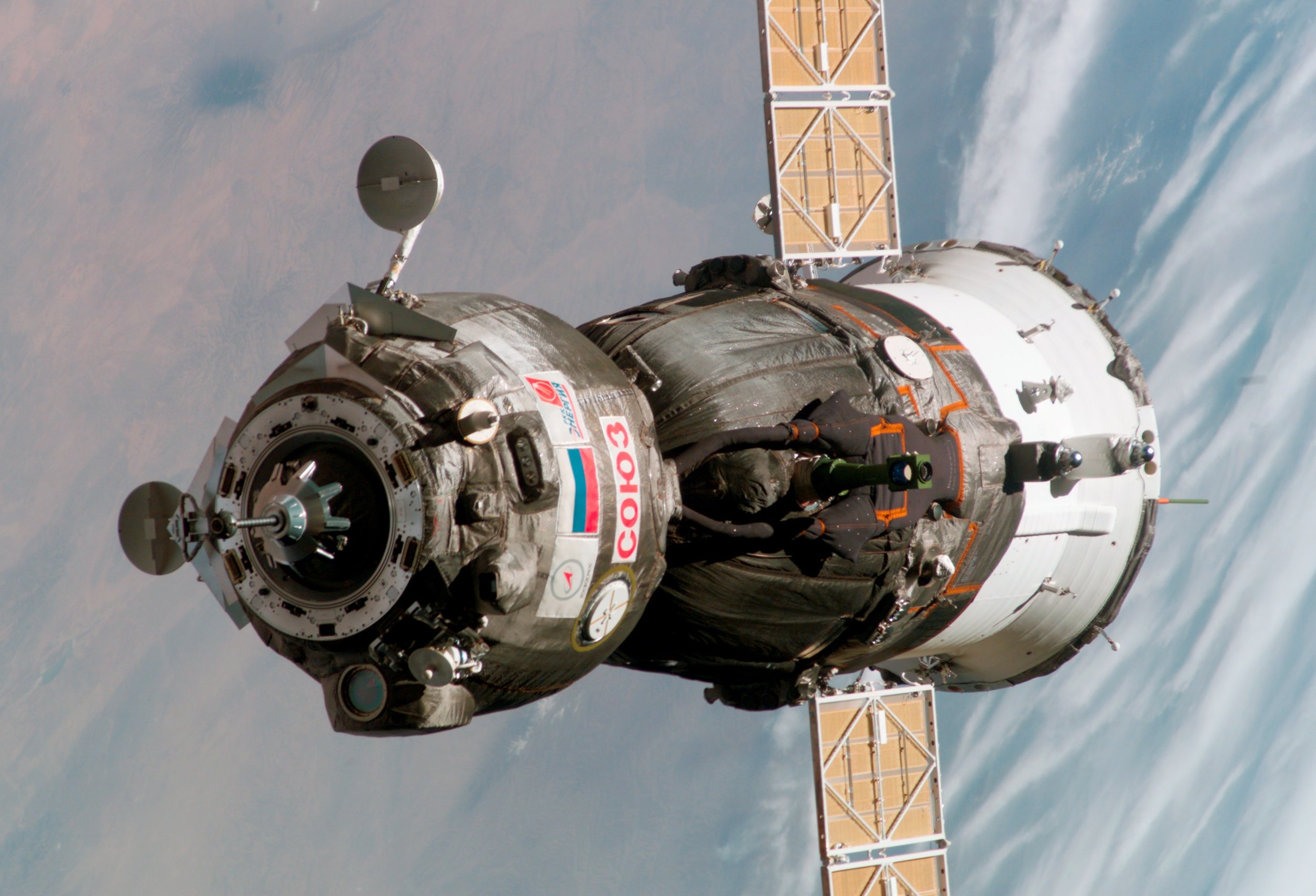
The Soyuz Program
Description of Parts
Soyuz-A manned spacecraft concept, circa 1963. Image credit: NASA
The Soyuz TMA-7 spacecraft departs from the International Space Station on April 8, 2006. Image credit: NASA
The Soyuz spacecraft, launched on a Soyuz rocket, has gone through many modifications over its years of service. Each modification was made to accommodate new uses for the craft or to make it more efficient. One thing that has not changed is its basic three component sections: an orbital module, a re-entry module, and a service module. In the current Soyuz configuration, the orbital module is used to dock with the ISS and carry cargo. The service module contains the engines, navigation instruments, and the solar panels. The re-entry module is the only section of Soyuz that returns to Earth and is where the crew rides.
The Soyuz program has had its share of setbacks over the years, including two fatal accidents. Despite these challenges, the Soviet (and now Russian) space program pressed onward, evaluating procedures and equipment, and introducing improvements on a continual basis.
“The Soyuz craft weighs tons, and you’re lying on the floor of it on your back. But the Russians do tell you, remember, before you land, stop talking so you don’t bite your tongue off.“
— Chris Hadfield, Canadian astronaut
The Soyuz 1 Tragedy
Colonel Vladimir Komarov and the Soyuz 1, circa 1967. Image credit: NASA
Soyuz 1 crash site west of Karabutak, Orenburg in the Soviet Union on April 24, 1967. Image credit: NASA
Memorial column with a bust of Komorov at the crash site. Image credit: Lyudmila F-S (CC BY-SA 4.0)
Soviet Cosmonaut Colonel Vladimir Komorov was a national hero following his flight on Voskhod 1 in 1964. Three years later he was designated the pilot of Soyuz 1, which was to go into orbit and rendezvous with
Soyuz 2.
Despite many technical concerns raised by respected Cosmonaut Yuri Gagarin and engineers who reported equipment failures on the spacecraft, Soyuz 1 was launched on April 23, 1967. Problems began almost immediately with solar panel deployment and the craft's orientation system. By the thirteenth orbit, the automatic stabilization system had failed.
Down on the ground the crew of Soyuz 2 was ready for a launch to possibly repair the compromised systems on Soyuz 1 but could not launch due to thunderstorms near the launch site in Kazakhstan.
The situation for Komorov and Soyuz 1 was desperate, so the flight director aborted the mission. During Orbit 18 the retrorockets fired and Soyuz 1 began its descent to Earth.
1964 Soviet Union 4 kopeks stamp celebrating Cosmonaut Vladimir Mikhailovich Komarov.
The craft's parachutes became tangled, and Soyuz 1 fell to Earth at a high rate of speed. After impact, the retrorockets began firing again on the ground, causing the spacecraft to catch fire. Rescue crews arrived far too late to help.
There is a memorial column with a bust of Komorov at the crash site. Komorov was posthumously proclaimed a Hero of the Soviet Union, his second such honor.
“Since the Columbia accident, the Russian space agency, or the Russian space program, has been literally carrying the load bringing us all the supplies we need on the Progress vehicle, smaller amounts on the Soyuz vehicles.”
— John L. Phillips, American astronaut
The Soyuz 2 Tragedy
The liftoff of Soyuz 2 on June 6, 1971. Image credit: NASA/RIA Novosti
American Astronaut Thomas P. Stafford, in dark suit at the left, helps carry the bier containing the ashes of Soyuz 2 Commander Georgi T. Dobrovolski, June 30, 1971. Image credit: NASA
In the late 1960s and early 70s, the Soviet space program was making good progress toward the establishment of orbiting space laboratories and a permanent human presence in space. In 1971, Soyuz 2 was the next objective toward those goals. The craft launched on June 6, 1971, and was to dock with the unmanned Salyut 1 space station.
The Soyuz 2 crew of Georgi T. Dobrovolski, Viktor I. Patsayev, and Vladislav N. Volkov in the Soyuz simulator. NASA/Images courtesy of RKK Energia.
Soyuz 2 successfully docked with Salyut on June 7 and the trio of cosmonauts moved into Salyut and began conducting scientific research.
On June 29th the three men wrapped up operations in Salyut and transferred back into Soyuz 2 and prepared for the journey back to Earth. Separation from Salyut went smoothly but, upon preparing for re-entry, things did not go as planned. Part of the re-entry procedure included casting off the work compartment. When the crew initiated this procedure the air seal between the two craft failed, causing immediate cabin depressurization in Soyuz. The cosmonauts, who were not wearing spacesuits, lost consciousness within seconds and died within minutes.
USSR stamp memorializes Soyuz 2 Cosmonauts Georgy Dobrovolsky, Vladislav Volkov and Viktor Patsayev who lost their lives shortly before landing on June 29, 1971.
A state funeral for the cosmonauts was held on July 1, 1971, in Moscow, with American astronaut Thomas P. Stafford representing the United States.
Following this tragedy, Soyuz was redesigned and every crew since has worn spacesuits during launch and reentry.
The Future
Mockup and test article of the Orel crew module, photographed at the Moscow Air and Space Show in August 2015. Wikipedia.com
Today, the Russian space agency Roscosmos is developing the Orel (Eagle) spacecraft to replace Soyuz. Orel will be at least partially reusable and will have different designs depending on the mission parameters. One version will be used in low earth orbit and a second version for lunar missions. Tentative dates for Orel include an uncrewed launch in 2023 and a crewed launch in 2025.










